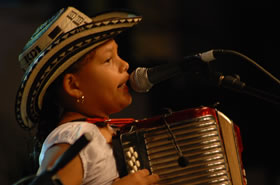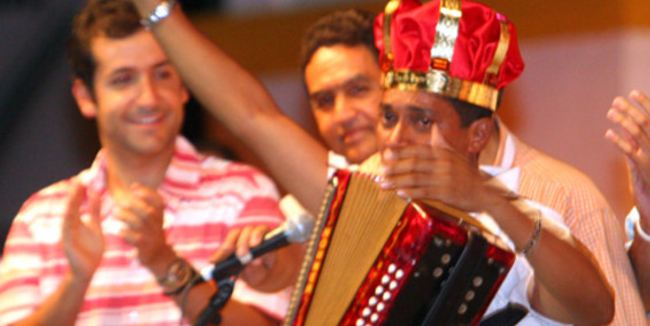The Vallenato Legend Festival (Spanish: Festival de la Leyenda Vallenata) is one of the most important musical festivals in Colombia.
The Festival features a vallenato music contests for best interpreter of accordion, caja vallenata and guacharaca, as well as piqueria (battle of lyrics) and best song. It’s celebrated every year in April in the city of Valledupar, Department of Cesar.
Literally, vallenato means ‘born in the valley’. The term now applies to the people of the city of Valledupar and to the generic name for the music of the region. Traditionally, the festival is celebrated in the capital of the department of Cesar. For five days, each year, the city becomes an enormous party, full of parades, shows, contests, and good music.
The most important event during the celebration of this festival is the vallenato musical contest.

- Festival de la Leyenda Vallenata: Valledupar, Cesar, April 29 to May 3
The winners are chosen by a vallenato experienced jury that evaluate the contestants’ prowess in the four main rhythms which are paseo, son, puya and merengue. There are several categories in which the contestants may participate including: “professional accordion player”, “amateur accordion player”, “young accordion player”, “best new vallenato song”, and piquerías (in which each competitor’s goal is to ‘diss’ their opponent through clever lyrics).
Besides the annual winners, there is also a special award given to renowned vallenato composers and performers, a statuette known as La Pilonera Mayor, which is given in recognition of the recipient’s dedication to vallenato music. La Pilonera Mayor is the highest honor given to a vallenato musician in Colombia and only six composers have received it until now. This award is given in honoris memoriam of disappeared Consuelo Araújo.
Its origin dates back to 1968 when the celebrated vallenato composer Rafael Escalona, the then governor of the state of Cesar and former president of the republic of Colombia, Alfonso López Michelsen, and the writer, journalist and former Minister of Culture Consuelo Araújo, came up with the idea of organizing a festival that celebrated vallenato, a musical genre that’s autochthonous to Colombia’s northern atlantic coast and also celebrate a religious festivity of “The Virgin of the Rosario”.
Since 1986, the organization of this festival rests in the hands of the Fundación Festival de la Leyenda Vallenata (Vallenato Legend Festival Foundation) a non-profit private entity in charge of the promotion, publicity and defense of vallenato music as one of the immaterial cultural legacies of Colombia.
The festival holds four main contests:
- Vallenato Music Typical Group in three categories: Professional, amateur, and children’s.
- Contest of Amateur Accordion Players.
- Unpublished Vallenato Song , with its four rhythms: merengue, paseo, puya and son.
And other contests:
King of Kings Contest. In addition to the yearly winners, every ten years a King of Kings is chosen from among the winners of the preceding decade. The best artist is awarded with La Pilonera Mayor prize, the highest possible award for a vallenato musician. Throughout the festival’s history, only six composers have obtained the award (name them).
Piquería are a kind of singing dialogue or duel, where participants confront each other through verses and rhymes, the winner being the fastest and most creative.
The Vallenata Legend which dates back to 1576 and recalls the famous Leyenda del Milagro (the legend of the miracle) that has to do with the conversion of the Chimla, Tupe, and Cariachile Indians to Catholicism following cruel confrontations with the Spanish army.
The festival is not limited solely to concerts and contests. One of its main attractions, beyond folk music and dances, are the pilonero parades. Piloneros are the region’s typical musicians.
Additionally, the festival offers numerous cultural proposals for all tastes. An art contest takes place before the festival, during which the promotional poster for the year is selected. And the legend of the miracle is staged by street theater groups.
The Legend: The legend says that during the Spanish colonial period, two amerindian tribes from the Tairona culture; the Tupes and the Chimilas, along with other members of other tribes, rebelled against the Spanish colonizers after one indigenous woman named Francisca who worked as a maid for a Spanish family was severely punished by her jealous master, who cut her hair and whipped her publicly. One of her fellow Indian tribesmen also working for the Spaniards, escaped and told his tribe’s cacique about this offensive insult.
The angry Indians organized an attack, destroying most of the town and killing many people. When trying to destroy the temple, the “Virgin of the Rosario” appeared and with her cape blocked their arrows preventing them from destroying it. The natives, scared, escaped to the Sierra Nevada de Santa Marta, and knowing that the Spaniards would follow them and would be in need of drinking water, they poisoned the “Sicarare lake”. This resulted in the death of all the Spaniards involved. The Virgin reappeared and began touching their bodies with her wand and reviving them. The surprised Indians finally surrendered.
Valledupar is a city and municipality in northeastern Colombia. It is the capital of Cesar Department and was founded in 1550 by the Spanish conquistador Hernando de Santana.

